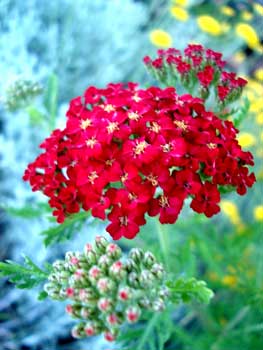
'Paprika' Yarrow
"His roof adorned a lovely spot,
Mid the black logs green glowed the grain,
And herbs & plants the woods knew not
Throve in the sun and rain."
-Alfred Billings Street
(1811-1881)
(1811-1881)
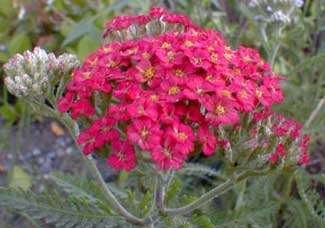 The majority of yarrow cultivars are derived from the Eurasian wildflower, but the German-bred cultivar 'Paprika' is an exception, derived from the California native yarrow, Achillea millefolium californicum.
The majority of yarrow cultivars are derived from the Eurasian wildflower, but the German-bred cultivar 'Paprika' is an exception, derived from the California native yarrow, Achillea millefolium californicum.Strictly speaking it's not just native to California, for its range extends into Oregon, Washington, Idaho, & British Columbia, but it is commonist along the California coast.
Native North American strains have hybridized with the commonly gardened Eurasian strains so that throughout their natural range, the purity of native wild strains is never certain. After two centuries of hybridization even throughout the natural landscape, purely native strains may well no longer exist.
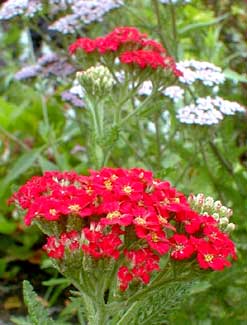 Numerous regional populations have been described in the taxonomic literature, but their status is not well documented nor universally agreed upon.
Numerous regional populations have been described in the taxonomic literature, but their status is not well documented nor universally agreed upon. As a broad generality, our North American races are tetraploid with narrow leaf-segments creating an uneven leaf surface, whereas the commonly gardened Eurasian varieties are hexaploid with flat leaves. At quick glance the leaves all look rather the same, a bit like asparagus fern, & it can take a microscope to detect a difference.
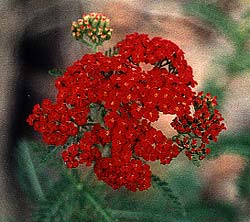 Some have said the German variety 'Fanal,' aka 'The Beacon' or just 'Beacon,' is the same as 'Paprika.' Others suggest that Beacon/Fanal is a distinct variety, & might even be a hybrid of A. millefoilum with A. taygetea, tending to be orange-red rather than scarlet like 'Paprika.'
Some have said the German variety 'Fanal,' aka 'The Beacon' or just 'Beacon,' is the same as 'Paprika.' Others suggest that Beacon/Fanal is a distinct variety, & might even be a hybrid of A. millefoilum with A. taygetea, tending to be orange-red rather than scarlet like 'Paprika.''Paprika' has fragrant long-lasting bright scarlet flowers with a yellow eye. It starts out mostly scarlet & then fades to rosy-pink, while the yellow eye increases in size until the whole flower begins to look yellow, as shown in the last photo on this page.
The bloom then slowly fades to white, then dries to brown. It can be harvested at any of these color phases for drying, & will hold that color for dry flower arrangement. But to get the brightest red rebloom, deadheading should be done at the yellow stage, before it expends energy on seed.
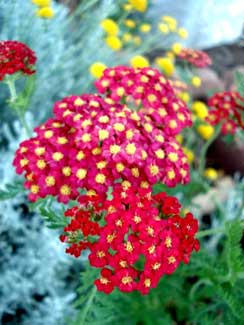 Deadheading before they go to seed will extend the blooming period at least until first frost. If it goes to seed it may stop blooming until the following year.
Deadheading before they go to seed will extend the blooming period at least until first frost. If it goes to seed it may stop blooming until the following year.Our first clump of 'Paprika' began as a very tiny start with other varieties equally small placed around an evergreen Strawberry Tree. Of the several varieties placed in this location, 'Paprika' was the slowest to establish, the most stunted in growth, spreading only a tiny bit in three years, despite that in a less difficult location it would have spread over a foot in that amount of time.
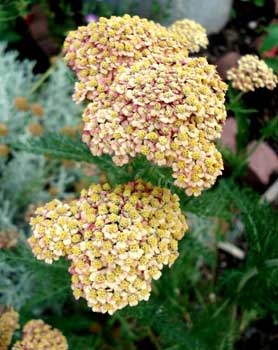 But it bloomed every year even so, shown in the first photo in July (2001).
But it bloomed every year even so, shown in the first photo in July (2001).Seven years later during a an endless winter deluge that lasted into early spring, this clump rotted out of the garden, but was immediately replaced though in a slightly raised bed in case we have another deluge-winter.
A second clump's blooms are shown in the second & third photos from June (2004). The third photo shows in the background another yarrow, 'Lavender Deb,' which starts out lilac-colored but fades to an off-white. The second photo shows the bloom not quite the rich pure scarlet it starts out being.
The last photo is from July (2009), from the clump that replaced the one that rotted out during the deluge. This one's in a slightly raised bed with freshly churned & enriched soil.
So this clump grew like a sun-of-a-gun compared to prevous clumps of 'Paprika,' then promptly "lodged" or fell over as is typical when yarrows grow too fast in rich soil. I staked it back up & it was no worse for flower.
Overall, 'Paprika' is smaller, slower, & a little bit later-blooming than the several other yarrow cultivars we have, & it is one of my favorites for brightness of color, though a more recent red cultivar, 'Strawberry Passion,' may well have it beat.
Continue to:
'Lavender Beauty' Yarrow